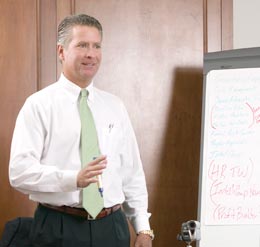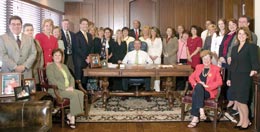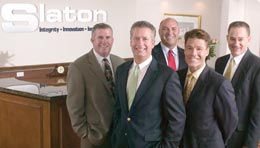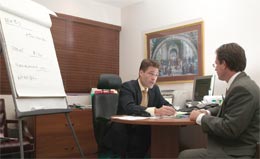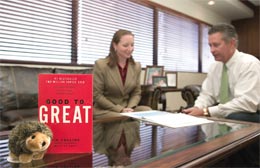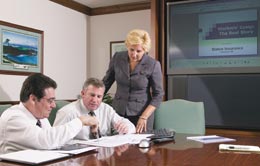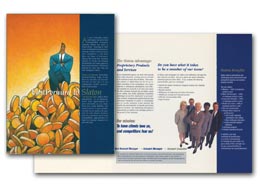 |
 |
 |
|
MARKETING AGENCY OF THE MONTH Rara avis Les Breedlove was inspired at an early age to be an insurance agent By Dennis H. Pillsbury Rarely do I hear from one of our featured agents that his or her dream was to be in insurance. I do, however, almost always hear that they are glad they are. James “Les” Breedlove is rara avis—all too rare in that, since he was in the 11th grade, he wanted to work in the insurance industry. That’s because the father of his best friend and his All Star baseball coach, Mr. Smith, worked for Allstate Insurance. Mr. Smith was an inspiration to Les who decided: “I wanted to do what Mr. Smith did.” And it wasn’t just because he would have wanted to do anything that this admired coach did. It was because Mr. Smith went out of his way to educate Les. “He explained the importance of insurance to me,” Les remembers. “He took me to his Allstate Insurance office so I could see what was involved, and he explained how it was a business where I could make as much as I wanted as long as I was willing to put in a strong effort.” Which brings us to a point—why do we do such a terrible job of promoting an industry that is integral to the economy and offers unlimited opportunities to learn and grow? But that’s not what this story is about. It’s about Slaton Insurance in West Palm Beach, Florida, and how this more than 80-year-old agency has grown significantly since Les took over the helm. And it’s also a little bit about serendipity and how Les and George Slaton crossed paths when Les was headed to a direct writer. Slaton Insurance was formed in 1923 by George W. Slaton and then purchased by his sons, George and Jake, in the 1960s. Insurance was not the only venture for the Slaton family, so the agency remained fairly small, providing a comfortable second or third income. By 1984, premium volume totaled around $600,000, primarily from personal lines. Serendipity strikes In that year, Les graduated from college and, not surprisingly, looked at positions with Allstate and Nationwide and even gleaned an offer from State Farm, which he had every intention of accepting. But serendipity in the form of an older sister was about to enter stage left. Les’s sister worked at a large regional bank of which George Slaton was chairman. “She said I really needed to talk to George,” Les says. In the interest of family harmony, he did. “I had every intention of meeting with George and then taking the State Farm job,” Les recalls. “That way I could tell my sister I met him and it just wasn’t right for me.” Obviously, that isn’t what happened. Les wound up talking to George for about three hours, hearing about the virtues of being an independent agent and the opportunities that were waiting for him at Slaton Insurance. “I put off my decision for three weeks and then asked George if I could come back and see him at the agency. When I got there, I saw there were only three people at the agency and I realized I had a tremendous opportunity.” He joined as a commission-only producer and made about $8,000 in that first year. “But I had proven myself to George. I was building a book and I wasn’t afraid to work,” Les notes. By 1986 Les became part of top management, and in 1988 he purchased the agency. Today, he is president of an agency with 42 people and $7.5 million in revenue. But Les’s walk along the road to that success was not smooth and included a few missteps and a nasty hurricane that served as learning experiences. Lessons learned “When I took over, my main concern was filling the pipeline with prospects,” Les says, “I found a couple of guys, including a debit life guy, who were great at doing that. We were rolling until 1992, when Hurricane Andrew rocked our world. “We lost long-standing contracts with companies that no longer wanted to write business in our area—at any cost. We had provided good business to those companies. In fact, our loss ratio with one of those companies had never been higher than 25% in the eight years that I’d been with the agency. But they still canceled us. It really scared me. I knew I needed a different strategy, so I began to open offices in other parts of the state, hoping to keep those companies that were left by offering them business that was not on or near the coast, and started an employee leasing company. “It worked,” Les says. “We were fortunate to hang on to some relationships because of the spread of risk. But there was a downside. It wasn’t just the risks that were spread—management was spread pretty thin as well. I eventually had seven offices throughout Florida and the employee leasing firm. We were working hard to keep revenue coming in the door, but I was on a treadmill running from office to office trying to put out fires. We did not have a focus or direction. We were just running fast. At the end of 2001, I sold the employee leasing firm which had nearly 4,000 employees by then. But I was still being pulled in too many directions. I knew I needed help and I saw a ‘Dare to Soar’ flyer from Roger Sitkins.” Les went to the day-and-a-half session and “really got bumped around. The poking and prodding from Roger made me realize that I just wasn’t getting the job done. We were just writing business without a plan, and not knowing if it was profitable. I was a little depressed when I left that meeting, thinking: ‘I have to change.’ “At about that time, Roger was conceptualizing his Sitkins 100™. I had never invested that kind of money in anything other than technology, but I felt that I needed to find out how to change my agency into a sales organization, so I bit the bullet and joined. It has turned out to be my single best investment. I brought all my people into the first producer boot camp. At that meeting, Roger pulled me aside and asked me why I had so many branch offices. I told him about what happened after Hurricane Andrew. He recommended that I run the numbers on our entire book with the 80/20 Rule in mind and look at where that put the branch offices. ‘Analyze profit versus hassle,’ he told me.” I started the project and was dumbfounded by the initial results. We had nearly 8,000 clients and $6 million in commission income. The smaller clients were sucking away time. We were underserving the revenue generators. I also found that most of our best clients did not come from the branches. It was quite an eye opener.” Les went back home with a plan in mind. He sold the branches and, this year, completed the last piece in the plan by selling the personal lines book that was being handled out of the main office. The agency dropped the number of accounts from 8,000 down to 900 but has increased revenue to $7.5 million, all in one office. “The goal for our producers now is 50 accounts—each with $50,000 in commission income.” The results Slaton Insurance now is a sales organization that stresses high quality “boutique” service. The organization got away from quoting after realizing that “its was costing us 30% of our sales and general administrative expenses to land only 25% of the clients to whom we provided quotes. And they were the kind of clients who would leave if they got a better quote elsewhere,” Les explains. “We have six producers plus myself and incredible depth in the trenches, so those producers can go out and sell knowing that the promised service will be there. In fact, we continually hear from clients that other agencies that bump up against us are constantly saying, ‘Yeah, we can do that too.’ I couldn’t ask for a better endorsement. “Seventy-five percent of what we do is on a mid-term broker of record letter. When we approach a prospect, we find out if they are satisfied with their current agent and accompany that with 25 questions the prospect should ask himself or herself about the level of service they’re currently receiving for the commissions being paid. Inevitably, we get in the door. And when we do, we start out by getting the prospect to agree on the value of the service when comparing price. We don’t want price shoppers. We want to become business consultants to each of our clients. The 30% of expenses that we used to spend on quoting now goes in to providing meaningful services to our clients,” Les continues. “We’re very comfortable in having the value conversation with every prospect.” The Monday sales meetings emphasize the need to lead with the value-added. “We role play on ways to present this in a positive way that overcomes the fact that we’re often presenting to CFOs who expect to compare numbers. We video each other and work with each other on ways to overcome a core group of objections and, sometimes, a new objection that one of the producers may have run into. It’s practice, practice, practice. We don’t try to change a producer’s style, just work on the content.” One of the agency’s value-added strengths is IntelliComp™, a workers comp program that we developed “out of our knowledge from employee leasing,” Les explains. “We were paying about $6 million in premium with a $500,000 deductible. We got pretty good at controlling costs. We had an attorney, an HR person, a loss control person, occupational nurses, and an operations guy who knew IT really well. When we sold the employee leasing firm, I kept the HR person and the operations guy. I didn’t really have a place for them at that point, but they were very talented and I knew they would be valuable additions somewhere. “That turned out to be a good decision,” he says. “They’ve helped build IntelliComp. It provides help with hiring, uncovering fraud, fixing mods, and so on. It’s a service we offer free to clients with more than $250,000 in premium. In addition to a robust Web site, we also have a licensed adjuster, a private investigator, and an HR person on staff to work with clients on ways to reduce costs, and we have an occupational nurse on call.” The program has been so successful, it resulted in Slaton Insurance being named the Agency of the Year by the Institute of WorkComp Professionals. “We’re also on the verge of putting our money where our mouth is,” Les continues. “We have such confidence in IntelliComp that we are starting an agency captive for workers comp in the Cayman Islands. We’ve identified about $2 million in comp premium that will be in the captive. This represents clients that have been with us for at least five years and have less than a 10% loss ratio. We’re enhancing the relationship to provide them with quicker recognition for their good loss performance, while improving our revenue as well. “This fits well with our goal of developing more revenue per relationship. Our current clients are our best customers and we want to provide them with a full range of services. One of those services is premium financing,” Les says. “We started our own premium finance company with the help of Cost Financial and will finance $12 million to $15 million for our clients.” Finding the right people “The plethora of CPCUs and CICs that we have backing up our producers also means that we can bring in sales superstars from other industries, like telecommunications and pharmaceuticals, where sales people start out at a nice income level but peak quickly. We’ve already brought two people in from these industries. They know how to get to the top and how to talk business. We have plenty of insurance technicians in the office to support them.” The agency has a formal recruiting, hiring, orientation and training program that is designed to find the best people and then train them to succeed in any part of the agency. And recruiting starts with current employees. “We recognize that the people who are best at telling others what a great place this is to work are our current employees,” Les says. “We provide an incentive for them to bring in new people to share in our success. We pay for our people’s CE credits and take advantage of other educational opportunities and, naturally, when they’re attending classes, they meet other insurance people. If they find someone they think will help our agency and get that person to call us, we pay the employee $250 on the spot. If that person is hired, the recommender gets another $250. If the new hire completes the 90-day probation period, the recommender gets $2,000. That’s a big motivator to get people to recruit for us.” Hiring occurs only after a candidate has met with the HR person, the potential department head, and Les. “Then we huddle up in a committee and make a decision. Turnover is very expensive. We want to protect our unique culture. We don’t want to make a mistake.” Orientation is intensive. “The new hire spends the first 30 minutes with me. I go over our business model, how we sell and give them the Slaton playbook. It shows all our numbers and our critical indicators, as well as our three-year business plan. We show them what it takes to succeed. It took me a long time to open up. But if we want people to feel like they are part of the business and that they can have an impact, then they need to know what we’re all about. Everybody gets the book Good to Great, and they’re expected to read it. I give them 30 days to finish it and then give them a questionnaire with eight or 10 questions about the book. When they complete the questionnaire, we pay them $100. It’s a nice incentive and it means that when we have meetings and talk about some of the concepts in the book, everybody knows what we’re discussing. It’s all part of our effort to ‘get the right people on the bus.’” Training is the responsibility of the department head and a couple of other people in the organization. There is a specific 90-day path that is outlined for each job. After they’ve completed the 90-day training, “we talk to them about getting the CIC or AAI. Each person is given a clearly defined career path and an opportunity to make some really good money. This is just starting to take hold,” Les says. “Three years from now, this will have a huge impact. We don’t even know yet where this will lead. We have some very talented people working to make a positive impact on the organization. It’s going to be pretty special.” As far as we’re concerned, it already is pretty special. That’s why we’re pleased to recognize Slaton Insurance as our Marketing Agency of the Month. * |
|
|||||||||||||||||||||||||||||
| ||||||||||||||||||||||||||||||
